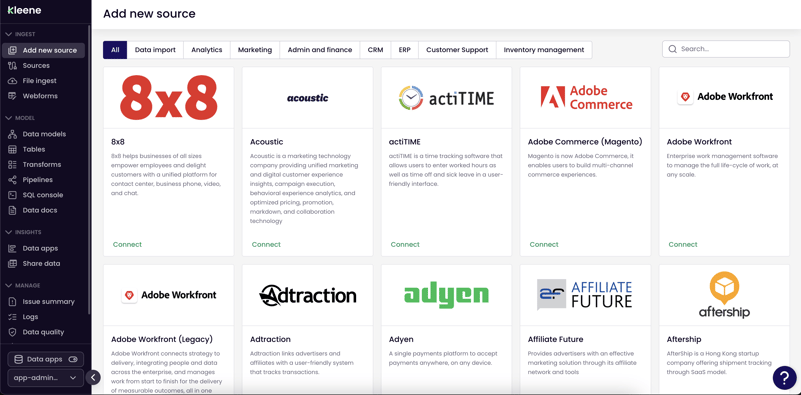There’s no denying that today’s retail industry is ultra-competitive. According to the World Economic Forum, UK retail has secured the third spot for competitiveness worldwide, while OFCOM ranks the UK number one in the world for online retail.
But to get that competitive edge, retailers need to harness the power of their data. To do this, they must invest in a solid, reliable, and consistent data system that analyses their data in a way that leads to more robust decision-making.
Building and implementing a data system is a significant task for senior leadership. This article explores the three primary approaches to implementing data systems: building from scratch, hiring a consultancy, or using a data platform.
We’ll explore the advantages and disadvantages of each option, highlighting the level of control, customisation, cost, and time considerations of each—so you can feel confident you’re making the right decision.
Build it from scratch
One way to build and implement a data system is to build it entirely from scratch. This approach is typically done in-house; you define what you want to achieve with your data and then gather a team of skilled individuals to build it from the ground up.
The goal is to consistently capture reliable data for strategic decisions that drive growth. The first step is to create a Single Source of Truth: a unified, reliable, and consistent data version that informs your decision-making. To do this, retailers must choose the right tools to store and process the data, aiming for zero discrepancies.
Pros of building and implementing your data system from scratch
Total control
Building a data system from scratch gives you complete control over the system’s design and functionality, enabling a highly customised solution tailored to your specific needs. You can also make adjustments without waiting for a third party.
Ability to scale
Your in-house team will be able to design a scalable architecture that grows as your business does, allowing you to anticipate future needs and integrate features that can handle increased data over time.
Robust data security
With total control over your data system, you’ll be equipped to implement security measures that are bespoke, robust, and designed to protect sensitive information—including security protocols, encryption methods, and access controls.
Cons of building and implementing your data system from scratch
High cost
Building a data system can be expensive. Senior leadership must invest substantial amounts of time, money, and people—including expenses related to hiring specialists, acquiring the proper hardware and software, and covering any development costs.
Long development time
Building a data system is also time-consuming. Even with the right team and software, the development process can take months and may cause delays in gaining critical insights.
Maintenance burden
Building your own data system means it’s your responsibility to maintain it. Without sufficient maintenance, it’ll be hard to address software updates and security flaws.
ROI isn’t guaranteed
Some retailers may find it challenging to ensure the teams working on building the system (technical specialists and engineers) understand the business case for what they’re building. If they don’t, this can have a direct impact on ROI.
Engage a consultancy
Another way to build and implement a data system is to engage a consultancy. They assess what you need, map out the project, and propose a plan with cost estimates. They’ll also use their expertise to build a data system that suits your business needs.
Pros of engaging a consultancy
Greater levels of expertise
A consultancy provides specialised expertise, including data architects, project managers, and developers, that enhance the development process and will implement a data system using industry best practices.
Faster deployment
With a wealth of experience under their belts, consultancies can easily navigate the development process and all its complexities, helping you get the data system up and running more quickly.
Cost control
While consultancy services come at a premium, they often work out more cost-effective. This is because the process is more predictable and manageable, helping you avoid surprise expenses by staying on a fixed budget.
Cons of engaging a consultancy
Less control
Engaging with a consultancy gives you less control over the development process, which may be challenging for senior leadership who prefer a hands-on approach. Compromises on certain features and functionalities may also be necessary.
Greater dependency
While a consultancy gives you access to a team of experts, it may also create a reliance on them, increasing the risk of ongoing costs and hindering in-house team skill development.
More upfront costs
Hiring a consultancy can involve hefty upfront costs. You’ll need to pay a premium on fees in exchange for top-quality services and software, which may be difficult for retail companies with smaller budgets.
Use a data platform
Opting for a data platform is another way to implement your data system, as it will help you to easily consolidate and centralise your data into a Single Source of Truth.
Some data platforms go even further than this—not only allowing you to ingest and transform data but using machine learning models (data apps) to give you even more advanced insight and recommendations. This will ensure you get an even faster ROI

While buying an off-the-shelf data platform may require sacrificing some bespoke configurations, it can be a very cost and time-effective way of implementing a data system. You will also benefit from the expertise and ongoing support of the vendor.
Kleene.ai is one of these solutions.
Pros of using a data platform
Rapid implementation
Data platforms offer pre-built data model kits, tools, and solutions that are ready to go. This provides immediate access to data-related capabilities—significantly reducing the time and effort required when an in-house team is tasked with implementing it.
Cost-effective
A data platform comes with pre-built features and tools, meaning the upfront developmental and maintenance costs are reduced. They also operate in cloud environments—like data warehouses—reducing the need to invest in hardware.
Typically, a standard retailer needs the equivalent of two or three full-time data engineers to build and maintain a data pipeline. An automated, off-the-shelf solution eliminates the need for human intervention, leading to cost reduction.
Greater scalability
As a business grows in size and responsibilities, the likelihood of increasing data sources rises, complicating the construction and maintenance of a data pipeline.
Many data platforms use standardised schemas that simplify this, alleviating challenges associated with building and maintaining a data pipeline while giving your data engineering team analyst templates they can benefit from.
Cons of using a data platform
Limited customisation
Some data platforms may lack customisation compared to building a bespoke solution from scratch, posing challenges for retailers with highly unique needs. That said, Kleene.ai offers hundreds of pre-built connectors and plug-and-play data apps that help you organise all your data, no matter its source.
Vendor lock-in
Depending on the chosen platform, you may be locked into a specific vendor’s ecosystem, reducing your flexibility to switch to another more suitable solution.
Data security concerns
For some businesses, entrusting sensitive customer data to a third-party platform may raise security concerns. It’s important to research the security protocols of each data platform before making your decision.
A note on combining approaches

For some retail businesses, there might also be value in combining the approaches we discussed above. For instance, you may want to develop tailored solutions in-house while relying on pre-built components and models for lower impact activities. Additionally, some companies, like Kleene.ai, also offer the expertise and support typical of a consultancy, but without relinquishing control of the project and while enabling scalability.
By doing this, you’ll be able to capitalise on the advantages of multiple strategies while ensuring you’ve got some level of control over how the system is implemented.
Empowering your retail decisions with data
It’s clear that building and implementing a robust data system is critical for retailers who want to succeed in the industry. Kleene.ai is the only decision-intelligence platform that organises all your data into a Single Source of Truth and helps you make better, faster decisions by leveraging machine learning data models and customisable analytics dashboards.
We’ve written an eBook to help you progress along your data journey. In it, we’ll help you identify where you currently sit in the data maturity curve and provide actionable advice on elevating your retail businesses’ data capabilities at each stage. Additionally, we provide insights on effectively navigating this transition.
Take advantage of this; download your free copy today.



